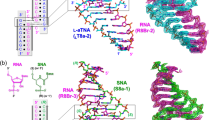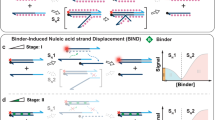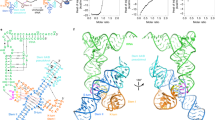Abstract
The design of synthetic ligands that read the information stored in the DNA double helix has been a long-standing goal at the interface of chemistry and biology1,2,3,4,5. Cell-permeable small molecules that target predetermined DNA sequences offer a potential approach for the regulation of gene expression6. Oligodeoxynucleotides that recognize the major groove of double-helical DNA via triple-helix formation bind to a broad range of sequences with high affinity and specificity3,4. Although oligonucleotides and their analogues have been shown to interfere with gene expression7,8, the triple-helix approach is limited to recognition of purines and suffers from poor cellular uptake. The subsequent development of pairing rules for minor-groove binding polyamides containing pyrrole (Py) and imidazole (Im) amino acids offers a second code to control sequence specificity9,10,11. An Im/Py pair distinguishes G·C from C·G and both of these from A·T/T·A base pairs9,10,11. A Py/Py pair specifies A,T from G,C but does not distinguish A·T from T·A9,10,11,12,13,14. To break this degeneracy, we have added a new aromatic amino acid, 3-hydroxypyrrole (Hp), to the repertoire to test for pairings that discriminate A·T from T·A. We find that replacement of a single hydrogen atom with a hydroxy group in a Hp/Py pairing regulates affinity and specificity by an order of magnitude. By incorporation of this third amino acid, hydroxypyrrole–imidazole–pyrrole polyamides form four ring-pairings (Im/Py, Py/Im, Hp/Py and Py/Hp) which distinguish all four Watson–Crick base pairs in the minor groove of DNA.
This is a preview of subscription content, access via your institution
Access options
Subscribe to this journal
Receive 51 print issues and online access
$199.00 per year
only $3.90 per issue
Buy this article
- Purchase on Springer Link
- Instant access to full article PDF
Prices may be subject to local taxes which are calculated during checkout



Similar content being viewed by others
References
Zimmer, C. & Wähnert, U. Nonintercalating DNA-binding ligands: specificty of the interaction and their use as tools in biophysical, biochemical and biological investigations of the genetic material. Prog. Biophys. Mol. Biol. 47, 31–112 (1986).
Dervan, P. B. Design of sequence-specific DNA-binding molecules. Science 232, 464–471 (1986).
Moser, H. E. & Dervan, P. B. Sequence-specific cleavage of double helical DNA by triple helix formation. Science 238, 645–650 (1987).
Thuong, N. T. & Helene, C. Sequence-specific recognition and modification of double-helical DNA by oligonucleotides. Angew. Chem. Int. Edn Engl. 32, 666–690 (1993).
Nielsen, P. E. Design of sequence-specific DNA-binding ligands. Chem. Eur. J. 3, 505–508 (1997).
Gottesfeld, J. M., Neely, L., Trauger, J. W., Baird, E. E. & Dervan, P. B. Regulation of gene expression by small molecules. Nature 387, 202–205 (1997).
Maher, J. L., Dervan, P. B. & Wold, B. Analysis of promoter-specific repression by triple-helical DNA complexes in a eukaryotic cell-free transcription system. Biochemistry 31, 70–81 (1992).
Duvalentin, G., Thuong, N. T. & Helene, C. Specific-inhibition of transcription by triple helix-forming oligonucleotides. Proc. Natl Acad. Sci. USA 89, 504–508 (1992).
Wade, W. S., Mrksich, M. & Dervan, P. B. Design of peptides that in the minor groove of DNA at 5′-(A,T)G(A,T)C(A,T)-3′ sequences by a dimeric side-by-side motif. J. Am. Chem. Soc. 114, 8783–8794 (1992).
Mrksich, M.et al. Antiparallel side-by-side motif for sequence specific-recognition in the minor groove of DNA by the designed peptide 1-methylimidazole-2-carboxamidenetropsin. Proc. Natl Acad. Sci. USA 89, 7586–7590 (1992).
Trauger, J. W., Baird, E. E. & Dervan, P. B. Recognition of DNA by designed ligands at subnanomolar concentrations. Nature 382, 559–561 (1996).
Pelton, J. G. & Wemmer, D. E. Structural characterization of a 2-1 distamycin A-d(CGCAAATTTGGC) complex by two-dimensional NMR. Proc. Natl Acad. Sci. USA 86, 5723–5727 (1989).
White, S., Baird, E. E. & Dervan, P. B. Effects of the A·T/T·A degeneracy of pyrrole-immidazole polyamide recognition in the minor groove of DNA. Biochemistry 35, 6147–6152 (1996).
White, S., Baird, E. E. & Dervan, P. B. On the pairing rules for recognition in the minor groove of DNA by pyrrole-imidazole polyamides. Chem. Biol. 4, 569–578 (1997).
Seeman, N. C., Rosenberg, J. M. & Rich, A. Sequence specific recognition of double helical nucleic acids by proteins. Proc. Natl Acad. Sci. USA 73, 804–808 (1976).
Steitz, T. A. Structural studies of protein-nucleic acid interaction: the sources of sequence-specific binding. Quart. Rev. Biophys. 23, 203–280 (1990).
Mrksich, M. & Dervan, P. B. Recognition in the minor-groove of DNA at 5′-(A,T)GCGC(A,T)-3′ by a 4-ring tripeptide dimer — reversal of the specificity of the natural product distamycin. J. Am. Chem. Soc. 117, 3325–3332 (1995).
Swalley, S. E., Baird, E. E. & Dervan, P. B. Discrimination of 5′-GGGG-3′, 5′-GCGC-3′, and 5′-GGCC-3′ sequences in the minor groove of DNA by eight-ring hairpin polyamides. J. Am. Chem. Soc. 119, 6953–6961 (1997).
Kielkopf, C. L., Baird, E. E., Dervan, P. B. & Rees, D. C. Structural basis for G·C recognition in the DNA minor groove. Nature Struct. Biol (in the press).
Pilch, D. S.et al. Binding of a hairpin polyamide in the minor-groove of DNA — sequence-specific enthalpic discrimination. Proc. Natl Acad. Sci. USA 93, 8306–8311 (1996).
Wong, J. M. & Bateman, E. TBP-DNA interactions in the minor groove discriminate between A:T and T:A base pairs. Nucl. Acids Res. 22, 1890–1896 (1994).
Brenowitz, M., Senear, D. F., Shea, M. A. & Ackers, G. K. Quantitative DNase footprint titration — a method for studying protein-DNA interactions. Methods Enzymol. 130, 132–181 (1986).
Swalley, S. E., Baird, E. E. & Dervan, P. B. Recognition of a 5′-(A,T)GGG(A,T)2-3′ sequence in the minor groove of DNA by an 8-ring hairpin polyamide. J. Am. Chem. Soc. 118, 8198–8206 (1996).
Kim, Y., Geiger, J. H., Hahn, S. & Sigler, P. B. Crystal Structure of a yeast TBP/TATA-box complex. Nature 365, 512–520 (1993).
Gartenberg, M. R. & Crothers, D. M. DNA-sequence determinants of CAP-induced bending and protein-binding affinity. Nature 333, 824–829 (1988).
Sluka, J. P., Horvath, S. J., Glasgow, A. C., Simon, M. I. & Dervan, P. B. Importance of minor-groove contacts for recognition of DNA by the binding domain of Hin recombinase. Biochemistry 29, 6551–6561 (1990).
Ades, S. E. & Sauer, R. T. Specificity of minor-groove and major-groove interactions in a homeodomain-DNA complex. Biochemistry 34, 14601–14608 (1995).
Baird, E. E. & Dervan, P. B. Solid phase synthesis of polyamides containing imidazole and pyrrole amino acids. J. Am. Chem. Soc. 118, 6141–6146 (1996).
Kelly, J. J., Baird, E. E. & Dervan, P. B. Binding site size limit of the 2:1 pyrrole–imidazole polyamide-DNA motif. Proc. Natl Acad. Sci. USA 93, 6981–6985 (1996).
Choo, Y. & Klug, A. Physical basis of a protein–DNA recognition code. Curr. Opin. Struct. Biol. 7, 117–125 (1997).
Acknowledgements
We are grateful to the NIH for research support and National Research service Awards to S.W. and J.W.S., to the NSF for a predoctorial fellowship to S.W., to J. Edward Richter for an undergraduate fellowship to J.M.T., and to the HHMI for a predictorial fellowship to E.E.B.
Author information
Authors and Affiliations
Corresponding author
Supplementary Information
Rights and permissions
About this article
Cite this article
White, S., Szewczyk, J., Turner, J. et al. Recognition of the four Watson–Crick base pairs in the DNA minor groove by synthetic ligands. Nature 391, 468–471 (1998). https://doi.org/10.1038/35106
Received:
Accepted:
Issue Date:
DOI: https://doi.org/10.1038/35106
This article is cited by
-
Targeting MYC with modular synthetic transcriptional repressors derived from bHLH DNA-binding domains
Nature Biotechnology (2023)
-
Telomere-specific chromatin capture using a pyrrole–imidazole polyamide probe for the identification of proteins and non-coding RNAs
Epigenetics & Chromatin (2021)
-
Novel polyamide amidine anthraquinone platinum(II) complexes: cytotoxicity, cellular accumulation, and fluorescence distributions in 2D and 3D cell culture models
JBIC Journal of Biological Inorganic Chemistry (2021)
-
DNA minor-groove binder Hoechst 33258 destabilizes base-pairing adjacent to its binding site
Communications Biology (2020)
Comments
By submitting a comment you agree to abide by our Terms and Community Guidelines. If you find something abusive or that does not comply with our terms or guidelines please flag it as inappropriate.



